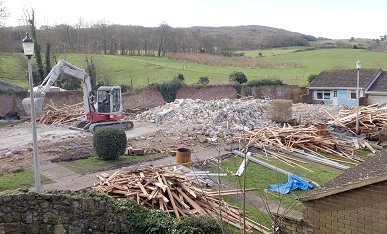During this last winter we received full planning permission for the final phase of the restoration program, started back in December 2012.
We set straight to work preparing the site of the original walled garden, which we intend to restore to its original state as documented in journals, biographies and the delicate watercolours of Helen Allingham.

This aerial photograph was taken in 1941 when Farringford was still owned by the Tennyson family.It shows the original planting schemes, with a central gravel path running east to west for easy access to the beds. The garden is further divided into a lower and upper section by a neat hedge. A range of potting sheds can be seen along the far side of the south garden wall. The formal layout is softened by mature trees and shrubs dotted here and there within the garden.
Self Catering Cottages
In 1945 Thomas Cook purchased Farringford and converted it into a hotel, and in the same year built the first group of self-catering cottages as separate accommodation for guests. This trend was continued after the estate was sold to Sir Fred Pontin, who in 1971 built a further eighteen self catering cottages, now known as Emilys cottages, on this site.

To date we have taken out ten of the eighteen Emilys cottages from the eastern section of the walled garden, and in the next few weeks the ground will be laid to turf.

Already it is possible to get a sense of the scale of the original garden, which was planted with flowers and shrubs among the fruit trees and vegetables. The Beds closest to the main central path were planted with flowers, and those further away the vegetables and fruiting trees. A lone survivor, the fig tree growing in the lower section of the garden opposite the four remaining Emily cottages with the picture windows, still bears fruit. Alfred and Emily may well have picked fruit from this tree.
One visitor in the autumn of 1868 was led to the kitchen garden and later described tobacco plants on each side of a long straight path towering over 7 feet high. (A Visit to Tennyson at Farringford Oct 1868 G.T.H Thomas, courtesy of Tennyson Research Centre) The Tennysons spent many happy hours here, tending to the beds or relaxing in the arbour, which Alfred, Lord Tennyson built for his wife Emily.
Further Restoration
In November 2014 we will demolish the remaining Emilys cottages and plant an evergreen hedge, to replace one that originally formed the north and east boundaries. We will then commence restoring the original brick walls, and replacing those sections constructed in more recent times with reclaimed bricks. It will take the best part of twelve months to restore all of the brick work. We will then be in a position to create the beds and borders and plan a planting scheme, in accordance with documented and photographic evidence and the Allingham watercolours.
